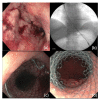Endoscopic Management of Esophageal Cancer
- PMID: 35892840
- PMCID: PMC9329770
- DOI: 10.3390/cancers14153583
Endoscopic Management of Esophageal Cancer
Abstract
Advances in technology and improved understanding of the pathobiology of esophageal cancer have allowed endoscopy to serve a growing role in the management of this disease. Precursor lesions can be detected using enhanced diagnostic modalities and eradicated with ablation therapy. Furthermore, evolution in endoscopic resection has provided larger specimens for improved diagnostic accuracy and offer potential for cure of early esophageal cancer. In patients with advanced esophageal cancer, endoluminal therapy can improve symptom burden and provide therapeutic options for complications such as leaks, perforations, and fistulas. The purpose of this review article is to highlight the role of endoscopy in the diagnosis, treatment, and palliation of esophageal cancer.
Keywords: diagnosis; endoscopic surgery; esophageal cancer; oncologic outcomes; staging.
Conflict of interest statement
The authors declare no conflict of interest.
Figures






References
-
- GBD 2017 Oesophageal Cancer Collaborators The global, regional, and national burden of oesophageal cancer and its attributable risk factors in 195 countries and territories, 1990-2017: A systematic analysis for the Global Burden of Disease Study 2017. Lancet Gastroenterol. Hepatol. 2020;5:582–597. doi: 10.1016/S2468-1253(20)30007-8. - DOI - PMC - PubMed
Publication types
LinkOut - more resources
Full Text Sources

